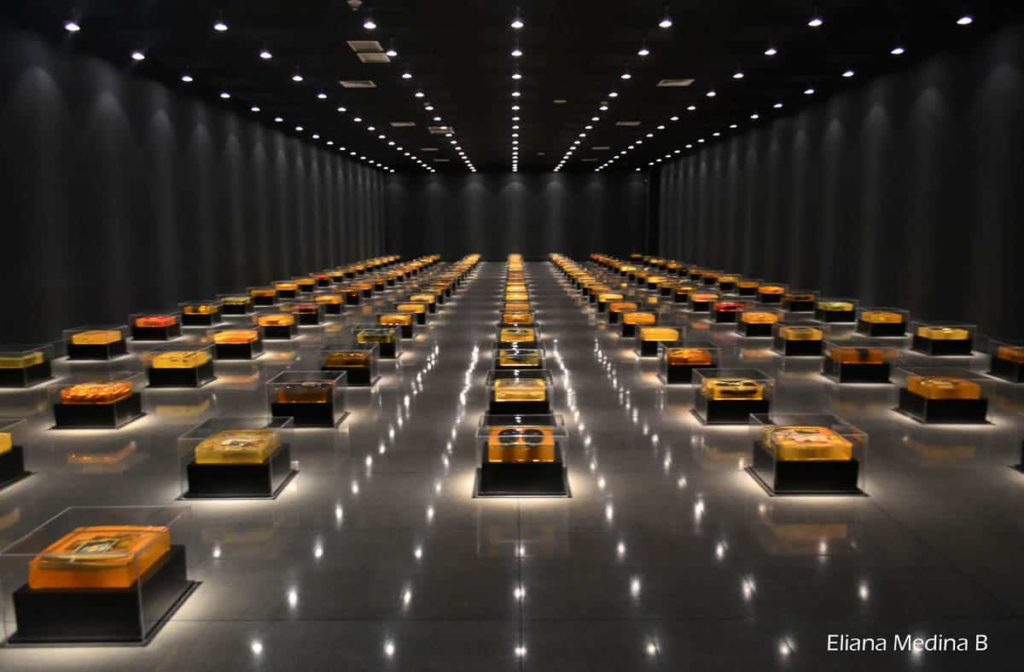
Erika Diettes, Relicarios installed at the Museo de Antioquia, Medellín
November 2016, photo: Eliana Medina B
The gallery doors are open. The space is subdued, walls dissolve into shadow. The only illumination is that reflected from the relicarios, each one in its own pool of light. The air is cool and dark, the blocks glow golden warm. Arranged in precise rows and aisles, they form an expansive matrix of memories that fills the entire space and spills into a smaller antechamber off to the right. There is a hushed stillness barely disturbed by the silent arrival of the families as they make their way between the rows of relicarios, searching…
In November 2016, the artist Erika Diettes opened an exhibition of works made in collaboration with the families of those who had been displaced, abducted, tortured, raped and murdered during the ongoing multilateral armed conflict in Colombia.
I had been invited by the artist to be one of two guests to “bear witness” to the event, the other person being Stephen Mayes, executive director of the Tim Hetherington Trust. Erika was concerned that, given the plethora of practical issues involved in staging and launching an exhibition and event like this, she would not have the attentional space to fully experience the activities as they unfolded. I was to open myself to the experience and reflect my thoughts and feelings back to the artist once the event was over.
There was no pre-arranged structure for how “bearing witness” might be achieved. I chose to keep detailed notes on the flow of events, the ideas they evoked and my immediate emotional responses. These I put together into a book, along with interviews with the museum’s director and conservator and a range of photographs. This was a personal sharing and there are just two copies of that book: one for the Erika and one for me. I have never worked in that way before, but it proved a powerful means by which to capture what are, too often, fleeting impressions that later consolidate as memories, while no longer remaining available as discrete intellectual and emotional experiences.
Entitled Relicarios, the installation at the Museo de Antioquia, Medellín, was both a private memorial and a means of making publicly visible the legacy of human grief the violence had left in its wake. The intention was to create a place of contemplation and memory, as the artist explained:
Long pathways lead the viewer around in the same way one would walk in a cemetery. The ‘relics’ are on the ground so that viewers must gaze downward, lowering their head, assuming a position of humility, devotion and respect … After all these years of conflict, we Colombians are grieving, and it is that grief that I want to make manifest.
For the past fifty years, Colombia has been the theatre of a multilateral armed conflict involving several distinct groups—left-wing guerrillas such as the FARC, paramilitaries established by the oligarchic land-owners, drug-trade crime syndicates, government forces—exacerbated by the involvement of the United States government and multinational business. All the main actors in this conflict have been accused of gross human rights violations. Over 200,000 people have died in the Colombian armed conflict, four in five were civilians, of which one quarter were children. Millions of villagers have been forced from their homes, creating the largest number of internally displaced people in any country in the Western hemisphere.
Relicarios was created in a partnership between the artist and the people living in the rural areas of Antioquia, Chocó, Urabá and other parts of regional Colombia. Erika established a studio in the hills of Antioquia, some 600 kilometres from her home in Bogotá. She worked with grief counsellors in the region to reach out to the local people and seek their collaboration. The news spiralled outwards, as Erika explained:
It led mourners to undertake journeys of up to thirteen hours on foot and five hours by bus just to come to my studio. For them, this was not simply a physical journey. They came to publicly honour the memory of their loved ones. To do so, they must hand over personal possessions, objects that once belonged to the Disappeared, treasured reminders they had preserved for periods of up to twenty years.
These they donated to the project along with their stories of love, life and the brutality of violent loss.
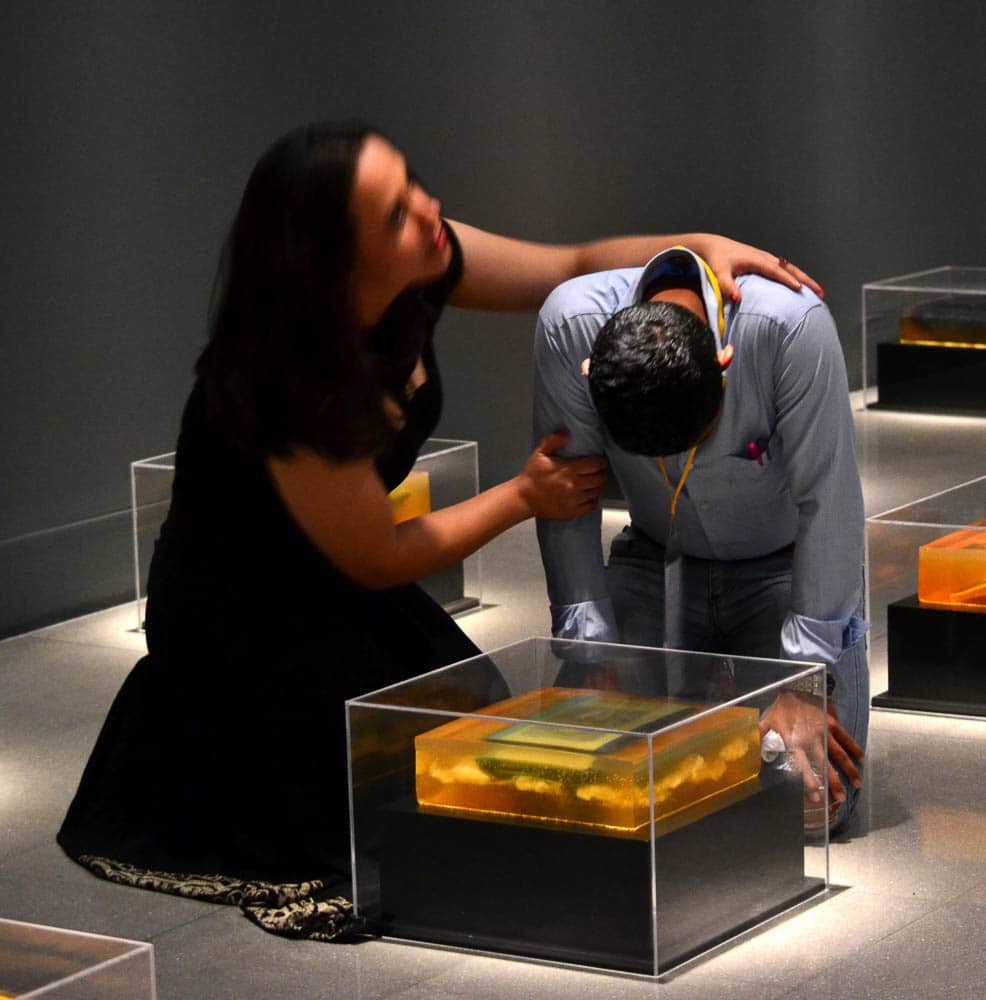
A grief counsellor, Nadis Londoño, comforts a young man at the reliquary of his father, who is one of the ‘Disappeared’, photo: Erika Diettes
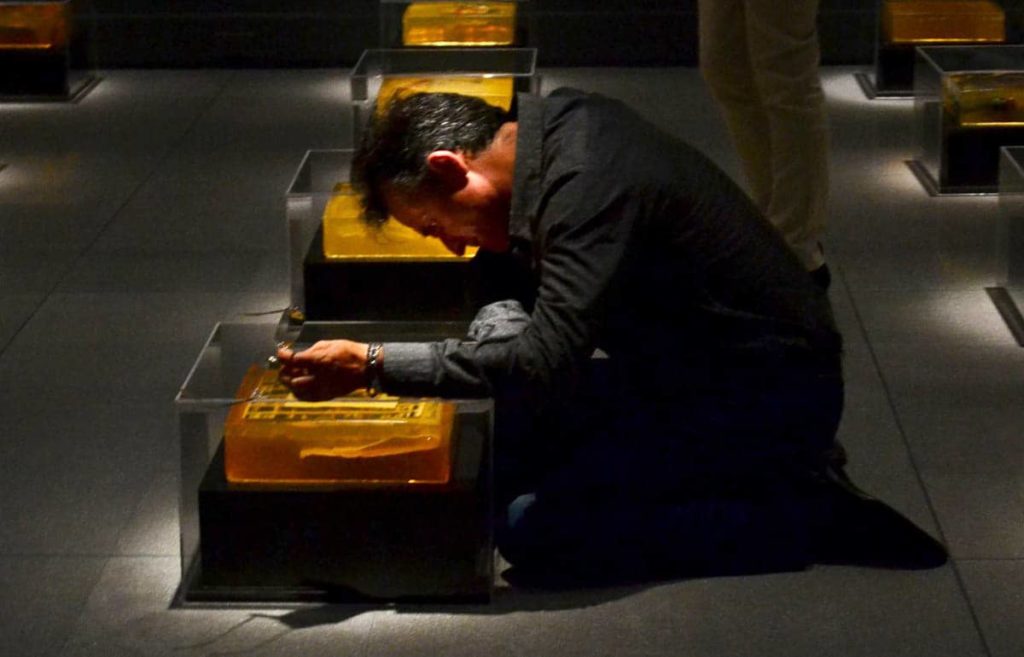
A grieving man kneels at the reliquary dedicated to his brother, who is one of the ‘Disappeared’, photo: Erika Diettes
Taking amber as her inspiration, Erika wanted to preserve each treasured item like ancient insects set in hardened resin. She began to work with a rubber tripolymer, a material familiar to industry but new to the field of art. She and her team of studio assistants experimented with the material to better understand its aesthetic properties. The tripolymer begins pale, but the more often it is heated, the darker and warmer its colour. Concerned that the blocks should not appear soft like toffee, special moulds were manufactured that ensure a crisp finish with smooth sides and sharp corners.
By pouring the tripolymer in layers, the objects in each block could be set in different relative planes, creating dimension, overlaying and an interplay of perspective.
Small bubbles trapped in the medium added to this sense of depth. But too many and the object became obscured. It took much trial and error to learn how to control the quantity and scale of the bubbles in order to create the desired final effect.

Erika Diettes, Relicarios 21, mixed media (donated objects set in rubber tripolymer), 30 x 30 x 12 cm, © Erika Diettes

Erika Diettes, Relicarios 121, mixed media (donated objects set in rubber tripolymer), 30 x 30 x 12 cm, © Erika Diettes
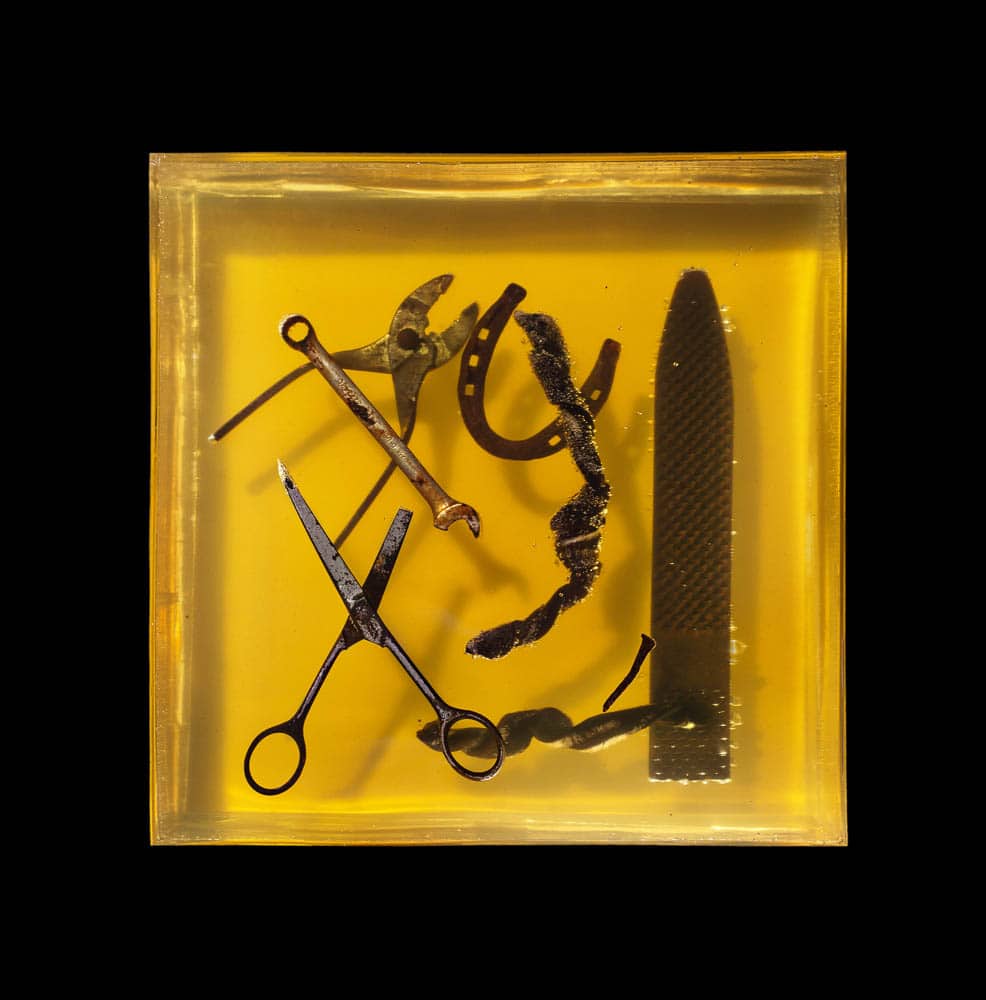
Erika Diettes, Relicarios 51, mixed media (donated objects set in rubber tripolymer), 30 x 30 x 12 cm, © Erika Diettes
The tripolymer was also new for the conservator at the museum, María Adelaida Bohórquez. The gel-like material requires a cool ambient temperature to maintain its shape. The surfaces are delicate and so clear acrylic hoods were created to protect each block. As a conservator, María was used to developing ways of handling new materials. The real impact of working on this exhibition was, for her, at the interface between the professional and the personal:
Each of the relicarios has a value to the person and to the country and to our history. My job is to conserve that value. Not only to conserve the materiality of the objects, but also conserve their intrinsic value. If the artwork has value to one person, or to many people, you must conserve it no matter what. For one person, for many people or for a whole country.
Before the exhibition opened to the public there were two days of workshops for the bereaved families, which I was permitted to witness. These were followed by a private viewing when the bereaved were reunited with the objects they had donated months or years before. The museum paid to fly in and accommodate more than two hundred bereaved family members. Even so, some people had walked from their houses for days to connect to the transportation. What I found most striking about the workshops was that there was little casting of blame. There was sadness, anger, bewilderment, but perhaps the greatest concern was that, amid the shifting politics of the ceasefire, the ones who were kidnapped, tortured, murdered and disappeared should not be forgotten. The importance of Relicarios was as both a personal memorial and a public acknowledgement of the trauma and loss that lay in the wake of decades of violence.
Erika Diettes’ exhibition opened at a pivotal moment in the history of the conflict. The previous month, Colombian President Juan Manuel Santos had been awarded the Nobel Peace Prize for negotiating a deal with the FARC that would bring them into the political system and end the guerrilla warfare. But, that same month, a public referendum intended to ratify the agreement had seen it rejected by a majority of the Colombian people, especially those living in and around Medellín.
Speaking with the director of the museum, Maria Del Rosario, she explained the importance of the exhibition in the life of the region; politically, emotionally and culturally:
The result of the referendum was shocking for us. People in Medellín mostly said no to the peace. But, as a museum, we have got to take risks; that is our job. This exhibition tells us a lot about ourselves: about our mentality, about our history, our blindness. We have to feel, and we have to trust Erika and what she does. Here in Colombia, we don’t have many opportunities like this one… we do not produce much art that uses beautiful objects to discover this kind of pain. I think that the way Erika involves the families creates a more complete way to understand how we must work through the art to understand our history.
While Relicarios has its public face in the museum, it also finds expression in the domestic. At a private event for the bereaved families to thank them for their courage and generosity in collaborating on the project, Erika Diettes gave each a framed photograph of their reliquary. These now hang in family homes across rural Colombia: votives that bring the departed home to their family while connecting them with the unfinished history of their nation.
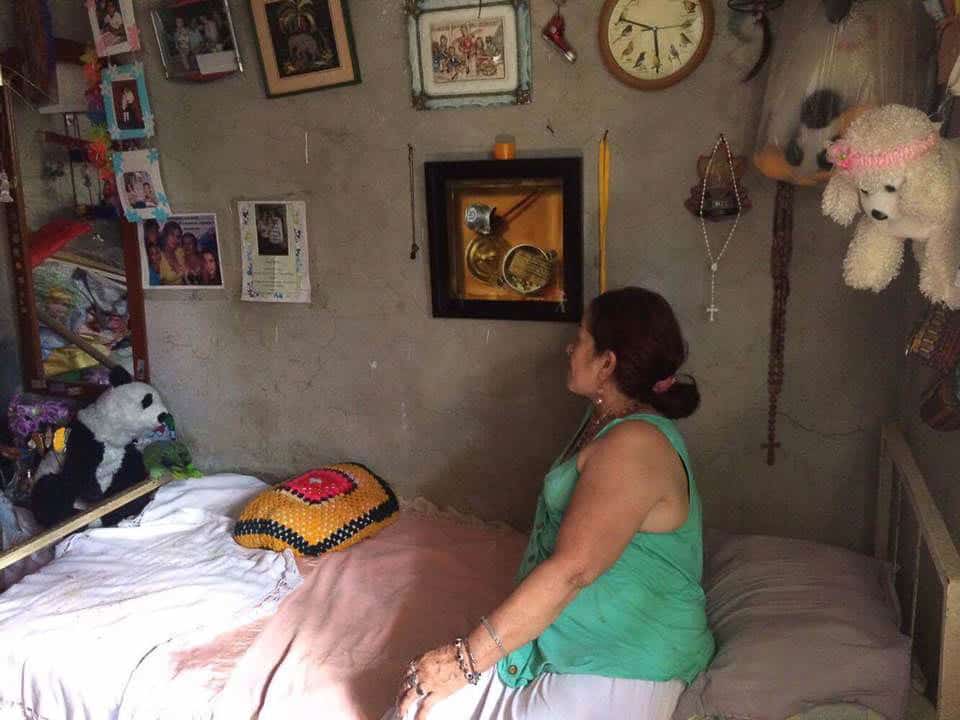
A woman regards the photograph of the reliquary that she received during the events at the Museo de Antioquia, which is now installed in her home in Medellín, photo: Erika Diettes
Relicarios was subsequently presented in Buenos Aires at the Centro Cultural De La MemoriaHaroldo Conti earlier this year.
Author
 Dr Alasdair Foster is a writer, researcher and award-winning curator initiating intercultural photography and visual art projects around the world, especially in Asia and the Pacific Rim. He is Adjunct Professor in the School of Art of RMIT University, Melbourne and a member of the university’s Contemporary Art, Society and Transformation research group. Dr Foster has 20 years’ experience heading national arts institutions and over 35 years of working in the public cultural sector. He was the founding director of Fotofeis festival, Europe’s largest photo event of the nineties (1991–1997) and director of the Australian Centre for Photography (1998–2011). He is currently Leverhulme Visiting Professor at Duncan of Jordanstone College of Art and Design in the University of Dundee, Scotland, working with faculty and researchers on the theme of photography as a disruptive medium in a post-global world.
Dr Alasdair Foster is a writer, researcher and award-winning curator initiating intercultural photography and visual art projects around the world, especially in Asia and the Pacific Rim. He is Adjunct Professor in the School of Art of RMIT University, Melbourne and a member of the university’s Contemporary Art, Society and Transformation research group. Dr Foster has 20 years’ experience heading national arts institutions and over 35 years of working in the public cultural sector. He was the founding director of Fotofeis festival, Europe’s largest photo event of the nineties (1991–1997) and director of the Australian Centre for Photography (1998–2011). He is currently Leverhulme Visiting Professor at Duncan of Jordanstone College of Art and Design in the University of Dundee, Scotland, working with faculty and researchers on the theme of photography as a disruptive medium in a post-global world.




